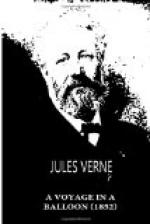REDACTOR’S NOTE
From Sartain’s Union Magazine of Literature and Art (Philadelphia: 1849-1852): May 1852: Vol. X. No. 5: p. 389-395.
John Sartain (1808-1897) was an English artist and engraver skilled in the art of mezzotint who emigrated to the United States; in 1848 he purchased a one-half interest in the “Union Magazine”, a New York periodical, which he transferred to Philadelphia. The name was changed to “Sartain’s Union Magazine”, and during the four years of its existence the journal became widely known, publishing works of Poe and other literati. The article here is a translation of “La science en famille / Un voyage en ballon. / (Reponse a l’enigme de juillet.)”, In: Musee des Familles. Lectures du soir, Paris, seconde serie. vol. 8, no. 11 (August 1851), pp. 329-336 (5 illustrations by A. de Bar, two chapters). This is a different version from the one published by Hetzel; “Un drame dans les airs”, in: Le Docteur Ox, 19 October 1874, (ed. C & D) (6 illustrations by Emile Bayard, only one chapter!).
In this early work we see the ingredients of Verne’s later Voyages Extraordinaires; characters brought or thrown together on a journey to afar; introduction of new characters part way through the story; careful scientific explanation of critical events (the ascension, filling the balloon, rising and falling, ballast); use of dialogue to convey scientific information (the history of ballooning); use of scientific instruments (barometer, compass); chapter heads to presage the story; escapes from perilous events caused by scientific or natural catastrophes.
One may also wonder why Hetzel removed the description of the inflation of the balloon with hydrogen gas. In fact hydrogen is barely mentioned in the revised story. Could it be that while Hetzel approved of Verne’s scientific descriptions of impossible undertakings, when it came to real exploits such as ballooning he did not want his juvenile readers experimenting with the “hogsheads of sulphuric acid and nails” to produce explosive hydrogen? In fact in the Hetzel version the lifting gas hydrogen is replaced with “illuminating gas”, an inferior, though lighter than air material, but one which his readers would find difficult to use for deadly experimentation.
It may also be that Verne had little to do with this volume; Hetzel may have edited the collection so that it would count as one of the required volumes Verne was to produce annually. The correspondence archives may shed some light.
Ms. Wilbur also translated other articles on ballooning from the French. It is also interesting that she retained in her translation the original units which Verne used (metre, feet, leagues), a practice forgotten until recently. This may be the first appearance of a work by Jules Verne in the English language.
Norman M. Wolcott
Rockville, Maryland




